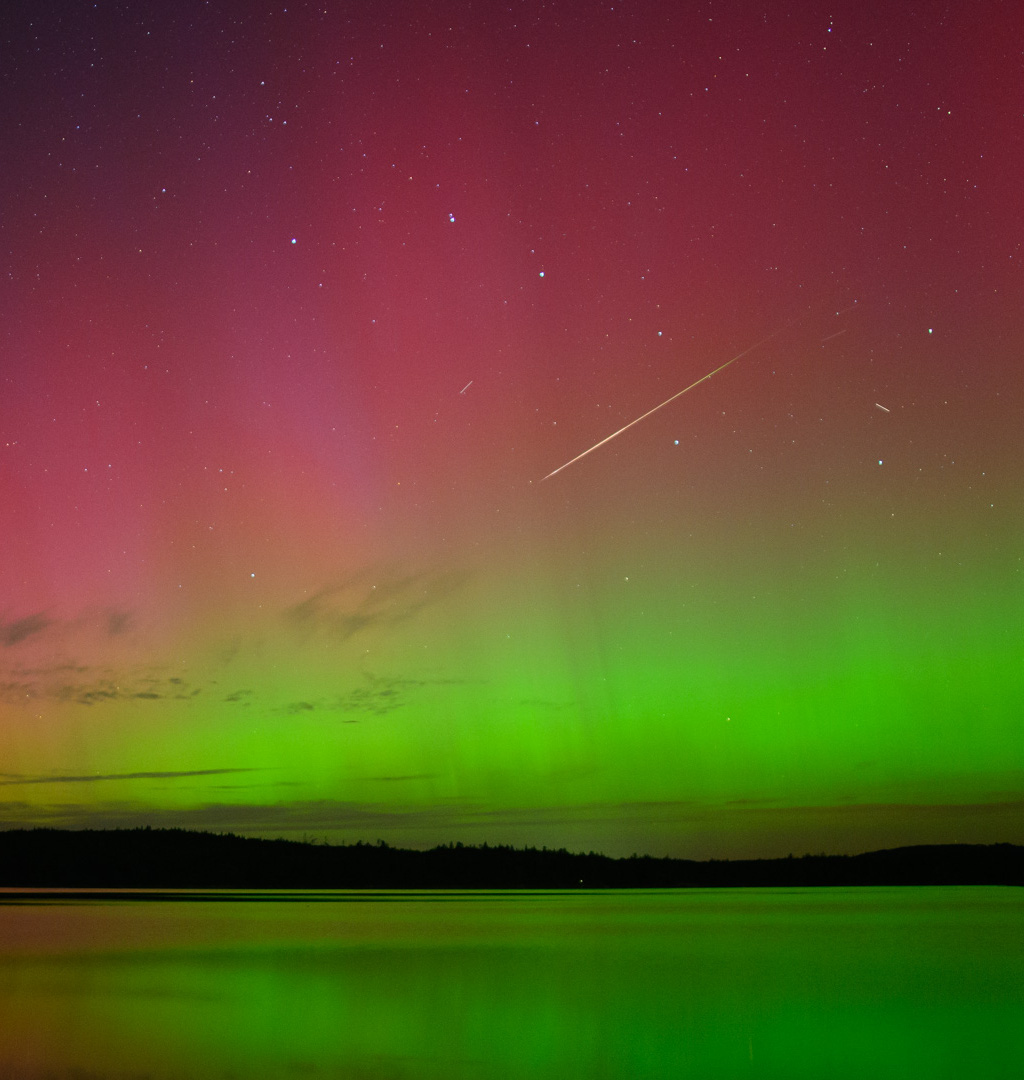Blog
A single exposure made with a camera pointed almost due north on August 12 recorded this bright Perseid meteor in the night sky west of Halifax, Nova Scotia, Canada. The meteor’s incandescent trace is fleeting. It appears to cross the stars of the Big Dipper, famous northern asterism and celestial kitchen utensil, while shimmering curtains of aurora borealis, also known as the northern lights, dance in the night. Doubling the wow factor for night skywatchers near the peak of this year’s Perseid meteor shower auroral activity on planet Earth was enhanced by geomagnetic storms. The intense space weather was triggered by flares from an active Sun.

Enoch Henry Light (August 18, 1907 – July 31, 1978 Canton, OH) was an American classically trained violinist, danceband leader, and recording engineer. As the leader of various dance bands that recorded as early as March 1927 and continuing through at least 1940, Light and his band primarily worked in various hotels in New York. For a time in 1928 he also led a band in Paris. In the 1930s Light also studied conducting with the French conductor Maurice Frigara in Paris.
Throughout the 1930s, Light and his outfits were steadily employed in the generally more upscale hotel restaurants and ballrooms in New York that catered to providing polite ambiance for dining and functional dance music of current popular songs rather than out-and-out jazz.
At some point his band was tagged The Light Brigade and they often broadcast over radio live from the Hotel Taft in New York, where they had a long residency. Through 1940, Light and his band recorded for various labels including Brunswick, ARC, Vocalion and Bluebird. In 1955, Light founded Grand Award Records and served as president and A&R chief. In 1959 he founded a subsidiary label, Command Records. Grand Award and its subsidiary labels were sold to ABC-Paramount Records in October 1959. Light’s name was prominent on many albums both as musician and producer.
more...Antonio Salieri (18 August 1750 – 7 May 1825) was an Italian composer and teacher of the classical period. He was born in Legnago, south of Verona, in the Republic of Venice, and spent his adult life and career as a subject of the Habsburg monarchy.
Salieri was a pivotal figure in the development of late 18th-century opera. As a student of Florian Leopold Gassmann, and a protégé of Christoph Willibald Gluck, Salieri was a cosmopolitan composer who wrote operas in three languages. Salieri helped to develop and shape many of the features of operatic compositional vocabulary, and his music was a powerful influence on contemporary composers.
Appointed the director of the Italian opera by the Habsburg court, a post he held from 1774 until 1792, Salieri dominated Italian-language opera in Vienna. During his career, he also spent time writing works for opera houses in Paris, Rome, and Venice, and his dramatic works were widely performed throughout Europe during his lifetime. As the Austrian imperial Kapellmeisterfrom 1788 to 1824, he was responsible for music at the court chapel and attached school. Even as his works dropped from performance, and he wrote no new operas after 1804, he still remained one of the most important and sought-after teachers of his generation, and his influence was felt in every aspect of Vienna’s musical life. Franz Liszt, Franz Schubert, Ludwig van Beethoven, Anton Eberl, Johann Nepomuk Hummel and Franz Xaver Wolfgang Mozart were among the most famous of his pupils.
Salieri’s music slowly disappeared from the repertoire between 1800 and 1868 and was rarely heard after that period until the revival of his fame in the late 20th century. This revival was due to the fictionalized depiction of Salieri in Peter Shaffer‘s play Amadeus (1979) and its 1984 film version. The death of Wolfgang Amadeus Mozart in 1791 at the age of 35 was followed by rumors that he and Salieri had been bitter rivals, and that Salieri had poisoned the younger composer; however, this has been proven untrue because the symptoms displayed by Mozart’s illness did not indicate poisoning and it is likely that they were, at least, mutually respectful peers. Despite denying the allegation, Salieri was greatly affected by the accusations and widespread public belief that he had contributed to Mozart’s death, which contributed to his nervous breakdowns in later life.
more...An international team of astronomers have used the NASA/ESA/CSA James Webb Space Telescope to discover gravitationally bound star clusters when the Universe was 460 million years old. 13bly. This is the first discovery of star clusters in an infant galaxy less than 500 million years after the Big bang. Young galaxies in the early Universe underwent significant burst phases of star formation, generating substantial amounts of ionising radiation. However, because of their cosmological distances, direct studies of their stellar content have proven challenging. Using Webb, an international team of astronomers have now detected five young massive star clusters in the Cosmic Gems arc (SPT0615-JD1), a strongly-lensed galaxy emitting light when the Universe was roughly 460 million years old, looking back across 97% of cosmic time. The Cosmic Gems arc was initially discovered in NASA/ESA Hubble Space Telescope images obtained by the RELICS (Reionization Lensing Cluster Survey) programme of the lensing galaxy cluster SPT-CL J0615−5746. With Webb, the science team can now see where stars formed and how they are distributed, in a similar way to how the Hubble Space Telescope is used to study local galaxies. Webb’s view provides a unique opportunity to study star formation and the inner workings of infant galaxies at such an unprecedented distance. [Image description: A field of galaxies on the black background of space. In the middle is a collection of dozens of yellowish galaxies that form a foreground galaxy cluster. Among them are distorted linear features, which mostly appear to follow invisible concentric circles curving around the centre of the image. The linear features are created when the light of a background galaxy is bent and magnified through gravitational lensing. A variety of brightly coloured, red and blue galaxies of various shapes are scattered across the image, making it feel densely populated.

Luther Sylvester Allison (August 17, 1939 – August 12, 1997) was an Americanblues singer-songwriter and guitarist. He was born in Widener, Arkansas, although some accounts suggest his actual place of birth was Mayflower, Arkansas. Allison was interested in music as a child and during the late 1940s he toured in a family gospel group called The Southern Travellers. He moved with his family to Chicago in 1951and attended Farragut High School where he was classmates with Muddy Waters‘ son. He taught himself guitar and began listening to blues extensively. Three years later he dropped out of school and began hanging around outside blues nightclubs with the hopes of being invited to perform. Allison played with the bands of Howlin’ Wolfand Freddie King, taking over King’s band when King toured nationally. He worked with Jimmy Dawkins, Magic Sam and Otis Rush, and also backed James Cotton. Chicago Reader has called him “the Jimi Hendrix of blues guitar”.
more...Floyd Westerman (August 17, 1936 – December 13, 2007) was a Sisseton Dakotamusician, political activist, and actor. After establishing a career as a country music singer, later in his life he became an actor, usually depicting Native American elders in American films and television. He is also credited as
Floyd Red Crow Westerman.As a political activist, he spoke and marched for Native American causes.
He was born Floyd Westerman on the Lake Traverse Indian Reservation, home of the Sisseton Wahpeton Oyate, a federally recognized tribe that is one of the sub-tribes of the Eastern Dakota section of the Great Sioux Nation, located in the U.S. state of South Dakota. His Indigenous name Kanghi Duta means “Red Crow” in the Dakota language (which is one of the three related Siouan languages of the Great Plains).
more...Columbus Calvin “Duke” Pearson Jr. (August 17, 1932 – August 4, 1980) was an American jazz pianist and composer. Allmusic describes him as having a “big part in shaping the Blue Note label’s hard bop direction in the 1960s as a record producer.” Pearson was born Columbus Calvin Pearson Jr. in Atlanta, Georgia, to Columbus Calvin and Emily Pearson. The moniker “Duke” was given to him by his uncle, who was a great admirer of Duke Ellington. Pearson performed with different ensembles in Georgia and Florida, including with Tab Smith and Little Willie John, before he moved to New York City in January 1959. He had, however, been able to get at least one song, “Tribute to Brownie” (dedicated to Clifford Brown), recorded by the Cannonball Adderley Quintet on their 1957 album, Sophisticated Swing. In New York, Pearson gained the attention of the trumpeter Donald Byrd, who saw Pearson performing with the Art Farmer/Benny Golson Sextet (known as the Jazztet). Shortly afterwards, Byrd asked Pearson to join his newly formed band, the Donald Byrd–Pepper Adams Quintet. Pearson was also the accompanist for Nancy Wilson on tour in 1961. During that same year, Pearson became ill before a Byrd-Adams show, and a newcomer, Herbie Hancock, took over for him. Hancock eventually took over the position permanently.
He was diagnosed with multiple sclerosis in the 1970s, from which he died in 1980 at Atlanta Veterans Hospital.
more...Ike Abrams Quebec (August 17, 1918 – January 16, 1963) was an American jazz tenor saxophonist. He began his career in the big band era of the 1940s, then fell from prominence for a time until launching a comeback in the years before his death.
Critic Alex Henderson wrote, “Though he was never an innovator, Quebec had a big, breathy sound that was distinctive and easily recognizable, and he was quite consistent when it came to down-home blues, sexy ballads, and up-tempo aggression.”
Quebec was born in Newark, New Jersey, United States. An accomplished dancer and pianist, he switched to tenor sax as his primary instrument in his early twenties, and quickly earned a reputation as a promising player. His recording career started in 1940, with the Barons of Rhythm.
Later on, he recorded or performed with Frankie Newton, Hot Lips Page, Roy Eldridge, Trummy Young, Ella Fitzgerald, Benny Carter and Coleman Hawkins. Between 1944 and 1951, he worked intermittently with Cab Calloway. He began to record for the Blue Note label in this era, and served as a talent scout (helping pianists Thelonious Monk and Bud Powell come to wider attention). Due to his exceptional sight reading skills, Quebec was also an uncredited impromptu arranger for many Blue Note sessions. Quebec’s comeback was short-lived; it was ended by his death in January 1963, at the age of 44 from lung cancer. He is buried at Woodland Cemetery, Newark, New Jersey.
more...Friday August 16th 6pm Accompaniment for Erev Shabbat Service with Inbal Sharett-Singer, Jayson Rodovsky, Jeff Bailey, Peter Whitman and mick laBriola.
more...NGC 7727 is a peculiar galaxy in the constellation Aquarius. It harbors two galactic nuclei, each containing a supermassive black hole, separated 1,600 light years apart.
This object is located at a distance of 23.3 megaparsecs (76 million light years) from the Milky Way and has a peculiar aspect, with several plumes and streams of irregular shape that explains its inclusion on Halton C. Arp‘s Atlas of Peculiar Galaxies with the number 222, being classified as a “Galaxy with amorphous spiral arms”. Gemini South, one half of the International Gemini Observatory operated by NSF’s NOIRLab, captures the billion-year-old aftermath of a double spiral galaxy collision. At the heart of this chaotic interaction, entwined and caught in the midst of the chaos, is a pair of supermassive black holes — the closest such pair ever recorded from Earth.

more...
Eddie Kirkland (August 16, 1923 – February 27, 2011 Kingston, JA) was an American electric blues guitarist, harmonicist, singer, and songwriter.
Kirkland, known as the “Gypsy of the Blues” for his rigorous touring schedules, played and toured with John Lee Hooker from 1949 to 1962. After his period of working in tandem with Hooker he pursued a successful solo career, recording for RPM Records, Fortune Records, Volt Records, and King Records, sometimes under the stage name Eddie Kirk. Kirkland continued to tour, write and record albums until his death in February 2011. His last performance, the night before his death, was at Dunedin Brewery, Florida.
more...Malcolm Earl “Mal” Waldron (August 16, 1925 – December 2, 2002 NY,NY) was an American jazz pianist, composer, and arranger. He started playing professionally in New York in 1950, after graduating from college. In the following dozen years or so Waldron led his own bands and played for those led by Charles Mingus, Jackie McLean, John Coltrane, and Eric Dolphy, among others. During Waldron’s period as house pianist for Prestige Records in the late 1950s, he appeared on dozens of albums and composed for many of them, including writing his most famous song, “Soul Eyes“, for Coltrane. Waldron was often an accompanist for vocalists, and was Billie Holiday‘s regular accompanist from April 1957 until her death in July 1959.
A breakdown caused by a drug overdose in 1963 left Waldron unable to play or remember any music; he regained his skills gradually, while redeveloping his speed of thought. He left the U.S. permanently in the mid-1960s, settled in Europe, and continued touring internationally until his death.
In his 50-year career, Waldron recorded more than 100 albums under his own name and more than 70 for other band leaders. He also wrote for modern ballet, and composed the scores of several feature films. As a pianist, Waldron’s roots lay chiefly in the hard bop and post-bop genres of the New York club scene of the 1950s, but with time he gravitated more towards free jazz. He is known for his dissonant chord voicings and distinctive later playing style, which featured repetition of notes and motifs.
more...Carl Perkins (August 16, 1928 – March 17, 1958) was an American jazz pianist.
Perkins was born in Indianapolis but worked mainly in Los Angeles. He is best remembered for his performances with the Curtis Counce Quintet, which also featured Harold Land, Jack Sheldon and drummer Frank Butler. He also performed with Tiny Bradshaw, Big Jay McNeely in 1948–49, and played dates with Miles Davis in 1950. Following a short stint in the Army (January 1951 to November 1952), he worked intermittently with the Oscar Moore Trio (1953-1955) and the Clifford Brown–Max Roachgroup in 1954. He recorded with Frank Morgan in 1955, and with his own group in 1956. Perkins composed the standard “Grooveyard”.
His playing was influenced by his polio-affected left arm, which he held parallel to the keyboard. He used his elbow to play deep bass notes. He was thus known as “the crab”.
He died of a drug overdose at age 29, in Los Angeles, California. He recorded one album, Introducing Carl Perkins, and a short series of singles under his own name. Authors Paul Tanner, Maurice Gerow, and David Megill cite Perkins as one of the best “funky”, or hard bop, piano players, but his early death prevented him from leaving a legacy.
more...
William John Evans (August 16, 1929 – September 15, 1980) was an American jazz pianist and composer who worked primarily as the leader of his trio. His use of impressionist harmony, block chords, innovative chord voicings, and trademark rhythmically independent, “singing” melodic lines continue to influence jazz pianists today.
Born in Plainfield, New Jersey, United States, he studied classical music at Southeastern Louisiana University and the Mannes School of Music, in New York City, where he majored in composition and received an artist diploma. In 1955, he moved to New York City, where he worked with bandleader and theorist George Russell. In 1958, Evans joined Miles Davis‘s sextet, which in 1959, then immersed in modal jazz, recorded Kind of Blue, the best-selling jazz album of all time.
In late 1959, Evans left the Miles Davis band and began his career as a leader, forming a trio with bassist Scott LaFaro and drummer Paul Motian, a group now regarded as a seminal modern jazz trio. In 1961, they recorded two albums during an engagement at New York’s Village Vanguard jazz club, Sunday at the Village Vanguard and Waltz for Debby; a complete set of their Vanguard recordings on three CDs was issued decades later. However, ten days after this booking ended, LaFaro died in a car accident. After months without public performances, Evans reemerged with a new trio, now featuring Chuck Israels on bass. In 1963, Evans recorded Conversations with Myself, a solo album produced with overdubbing technology. In 1966, he met bassist Eddie Gómez, with whom he worked for the next 11 years. During the mid-1970s, Evans collaborated with the singer Tony Bennett on two critically acclaimed albums: The Tony Bennett/Bill Evans Album (1975) and Together Again (1977).
Many of Evans’s compositions, such as “Waltz for Debby” and “Time Remembered“, have become standards, played and recorded by many artists. Evans received 31 Grammy nominations and seven awards, and was inducted into the DownBeat Jazz Hall of Fame.
more...More Posts
- World Music with Juan Serrano
- Daily Roots with I Kong
- The Cosmos with the Deneb Star
- Don Ellis Day
- Johnny Hodges Day
- Semmangudi Srinivasa Iyer Day
- World Music with Alim Qasimov
- Daily Roots with Jah Mel
- The Cosmos with NGC 2798
- Charles McPherson Day
- Billy Taylor Day
- World Fusion with La Cuneta Son Machin
- Daily Roots with Winston Jarrett
- New Orleans Legend Art Neville Dies
- The Cosmos with M82
- Allison Krauss Day
- Steve Lacy Day
- Champion Jack Dupree Day
- World Music with Benjamin Sylvestre Randafison
- Daily Roots with the Viceroys
